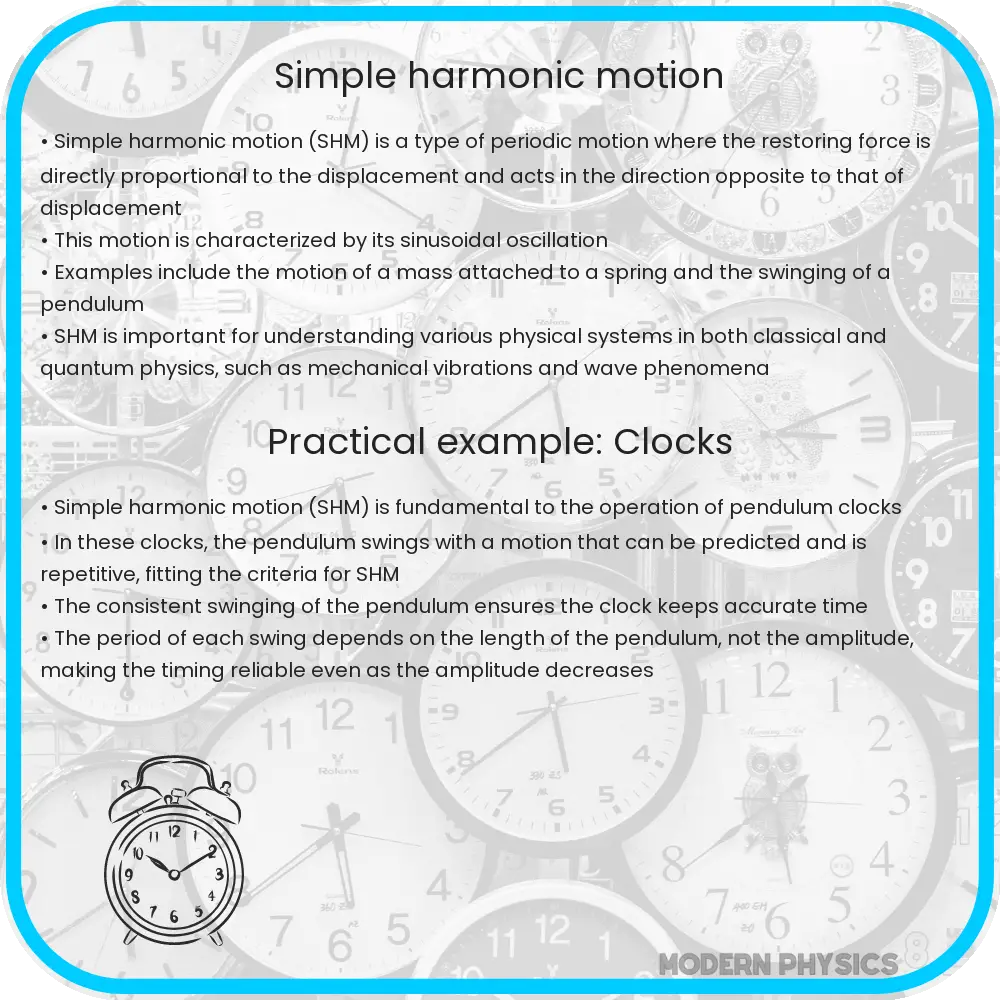Explore the fundamentals of Simple Harmonic Motion (SHM), its principles, equations, and real-world applications in physics and engineering.

Understanding Simple Harmonic Motion (SHM)
Simple Harmonic Motion (SHM) is a type of periodic motion or oscillation motion where the restoring force is directly proportional to the displacement and acts in the direction opposite to that of displacement. SHM is fundamental to the study of waves, sound, and other vibratory phenomena in physics.
Basic Principles of SHM
The most classical example of SHM is the motion of a mass attached to a spring. When displaced from its equilibrium position, the mass experiences a restoring force F which is proportional to the displacement x, according to Hooke’s Law: F = -kx. Here, ‘k’ is the spring constant, and ‘x’ is the displacement. The negative sign indicates that the force acts in the direction opposite to the displacement.
Equations of Motion in SHM
The motion of a simple harmonic oscillator can be described by the following differential equation:
\[ \frac{d^2x}{dt^2} + \omega^2x = 0 \]
where \(\omega\) (omega) is the angular frequency of the motion. This differential equation has solutions that can be represented as:
\[ x(t) = A \cos(\omega t + \phi) \]
Here, ‘A’ is the amplitude of the motion, \(\omega t + \phi\) is the phase, and \(\phi\) is the phase constant. The velocity and acceleration in SHM can also be described using similar sinusoidal functions.
Energy in SHM
In SHM, energy oscillates between kinetic and potential forms. The total mechanical energy E in SHM is constant and is given by:
\[ E = \frac{1}{2} kA^2 \]
where A is the amplitude. At maximum displacement, the energy is all potential, and at the equilibrium position, it is all kinetic.
Analysis of SHM
SHM provides an idealized model for understanding vibrational systems. Real-world systems often deviate from perfect SHM due to factors like damping and external forces. However, SHM is crucial for understanding the fundamental concepts in wave motion, resonant systems, and other areas of physics.
Further analysis involves exploring the effects of damping, forced vibrations, and resonance in systems exhibiting SHM.
Damping and Forced Vibrations in SHM
In real-world scenarios, SHM is often influenced by non-ideal factors such as damping and external forces. Damping is a force that opposes the motion and reduces the amplitude over time. It’s often proportional to the velocity and can be represented as:
\[ F_d = -b\frac{dx}{dt} \]
where ‘b’ is the damping coefficient. In the presence of damping, the system loses energy, leading to a gradual decrease in amplitude.
Resonance in SHM
Resonance occurs when an external force applied to a system matches its natural frequency, resulting in a significant increase in amplitude. The resonance phenomenon is crucial in many applications, including musical instruments, bridges, and building design. It’s crucial to understand and control resonance in engineering to avoid catastrophic failures.
Applications of SHM
SHM finds applications in various fields. In engineering, it’s used in the design of structures and machinery parts that experience oscillations. In electronics, oscillators that use SHM principles are fundamental in radios, clocks, and computers. In quantum mechanics, the harmonic oscillator model helps understand atomic and molecular vibrations.
Conclusion
Simple Harmonic Motion is a cornerstone concept in physics, providing a foundation for understanding oscillatory motion and waves. Its principles are not only fundamental in theoretical physics but also immensely practical in various engineering and scientific applications. From the basic understanding of springs and pendulums to the intricate design of electronic circuits and structural engineering, SHM continues to be a key concept, enriching our understanding of the natural and technological world. Its simplicity in form yet complexity in application makes it a fascinating and essential area of study in physics and engineering.
